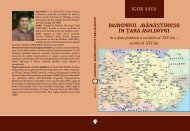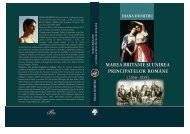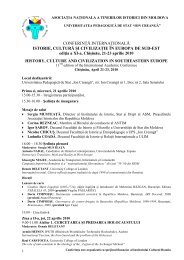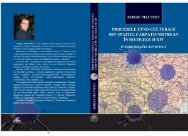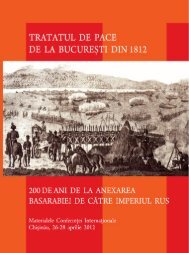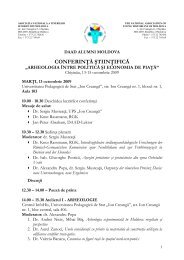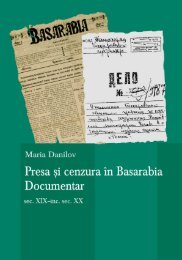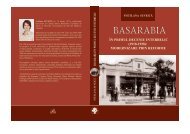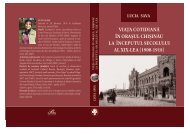Publicatie cu continut integral - Asociatia Tinerilor Istorici din Moldova
Publicatie cu continut integral - Asociatia Tinerilor Istorici din Moldova
Publicatie cu continut integral - Asociatia Tinerilor Istorici din Moldova
Create successful ePaper yourself
Turn your PDF publications into a flip-book with our unique Google optimized e-Paper software.
It was mistake of Russian administration. They automatically used in Baltic region those concepts which were<br />
normal for low educated Russian peasants without any concrete national and social identities. In the same time<br />
Baltic inorodtsy were more educated and they had numerous and various contacts with Baltic Germans. Ukrainian<br />
Canadian historian Stephen (Stepan) Velychenko presume that Russian imperialism was too weak for systematic<br />
anti-inorodtsy actions in non-Russian regions 1 . That it is why Russian authorities were not ready to National<br />
Awaking among Estonian and Latvian peasants. The fact that by the beginning of the 20th century modern Estonian<br />
and Latvian nations appeared was real and unpleasant surprise as for local Germans as for Russian administration.<br />
In the early 1900s Russian government did not know what to do with Latvians and Estonians. It was too<br />
late for assimilation – that is why dialogue begun.<br />
Russian officials also knew a little about Latgale. Probably, Latgale for them was local Ukraine in miniature.<br />
It was not Polish, it was not Belarus, but it also was not Latvian and Russian. In the same time Russian intellectuals<br />
were not able to imagine Latgale as Russian lieux de memoire because they by themselves had not concrete<br />
ideas about Russian historical memory and identity. In the 1917 Russian revolution destroyed Russian Empire and<br />
Latvia got independence. During period of active armed struggle for independence Latvian politicians were able<br />
to unite all territories which were Latvian for them inclu<strong>din</strong>g Latgale. In the same time many Latvian communists<br />
and social-democrats of extreme left orientation emigrated to the Soviet Russia.<br />
During the 1920s and early 1930s Soviets plaid with numerous non-Russian ethnic groups in different games<br />
which concerned their languages and identities. They declared politics of korenizatsiia which had different forms<br />
and expressions. As for political emigrants from Latvia, Soviets decided that among them were not only Latvians,<br />
but Latgalians also. In such situation Latvian and Latgalian communities in the USSR co-existed. But in the<br />
middle of the 1930s Soviet government suddenly decided that it was impossible to organize communistic revolution<br />
in Latvia and Soviet officials decided that there is no more need in emigrants. On another hand national policy<br />
changed greatly and numerous Latvians and Latgalians were repressed. But, Russian Soviet officials, like their<br />
Russian predecessors in Russian Empire, mistaken.<br />
In 1939 – 1940 Latvian Republic was oc<strong>cu</strong>pied and incorporated in the Soviet Union as LSSR – Latvian Soviet<br />
Socialist Republic. For authors and ideologists of Soviet national policy it was not only Socialist, but mainly<br />
– Latvian. That is why, in such Latvia was no place for Latgale and Latgalians with their own language and<br />
separate identity. Soviets simply presented Latgale to loyal Latvian communists in Riga who declared that new<br />
type of nation, Latvian socialistic nation, appeared. Russians were not interesting in development of any separate<br />
Latgalian identity. Latgale in opposite to Ukraine or Belarus was too far from Russia mentally and was not part<br />
of Russian historical memory.<br />
Russian Soviet intellectuals had a little in common with Latgale and it wasn’t for them their own lieux de memoire<br />
like some for example some of Ukrainian regions. Soviet Russian intellectuals who lived in Russia practically<br />
did nothing for Latgalian studies. They preferred to present Latgale with its unique past to Latvian intellectuals.<br />
Perception of history was and still is the main battlefield for an identity 2 – that is why history was often used in<br />
intellectual debates which touched upon Latgalian past.<br />
Latvian intellectuals in the Soviet Latvia were firstly Latvian and secondly Soviet intellectuals. That is why<br />
they were ready to take such un-expected present from Russians as Latgale. It was so because Latvian historians<br />
and intellectuals by themselves tried to integrate Latgale to Latvia and Latgalian historical narratives to the great<br />
and common Latvian one. But in this way they met with numerous diffi<strong>cu</strong>lties. Historically Latgale and other<br />
Latvian lands developed under various historical influences. Vidzeme, Kurzeme and Zemgale belonged to the<br />
zones where German language and German political institutions dominated. Latgale was the zone where German<br />
influence was not such strong as Slavic one.<br />
That is why history by herself assisted to appearances of differences between Latvian lands. When in the mid<br />
of 19th century national movement made its first steps in Latvia – it moved quicker in Vidzeme and Kurzeme then<br />
in Latgale. Latvian nationalists, who were the first Latvian intellectuals also, tried to change situation and integrate<br />
Latgale to Latvian context. That is why they began <strong>cu</strong>ltivating their own image of Latgale as Latvian lieux<br />
1 VELYCHENKO, 1999.<br />
2 KOHUT, 2004, 219.<br />
– 0 –



